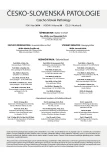Where does Ewing sarcoma end and begin - two cases of unusual bone tumors with t(20;22)(EWSR1-NFATc2) alteration
Authors:
Zdeněk Kinkor 1; Tomáš Vaneček 1; Marián Švajdler jr. 2; Petr Mukenšnabl 1; Karel Veselý 3; Jan Baxa 4; Milan Kokavec 5
Authors‘ workplace:
Bioptická laboratoř s. r. o., Šiklův ústav patologie, LF UK, Plzeň
1; Oddělení patologie, Univerzitní nemocnice L. Pasteura, Košice
2; I. patologicko-anatomický ústav, LF MU a FN u sv. Anny, Brno
3; Klinika zobrazovacích metod, LF UK, Plzeň
4; Ortopedická klinika, Univerzitní nemocnice Akademika Dérera, Bratislava
5
Published in:
Čes.-slov. Patol., 50, 2014, No. 2, p. 87-91
Category:
Original Article
Overview
The authors present two cases of Ewing-like sarcoma of the humerus and femur of a 12-year-old boy and a 28-year-old male, respectively. Identical morphology in both tumors consisted of multiple solid nests with a mosaic collection of small, round, uniform cells with clear cytoplasm and no apparent nuclear atypia. A monotonous structural arrangement, including both rich vascularity of bordering septae and significant admixtures of eosinophil leucocytes, resulted in a final organoid “neuroendocrine-like” pattern. Immunohistochemistry revealed diffuse strong CD10, CD99 and CD138 positivity. Detailed molecular analysis in both tumors confirmed translocation t(20;22) resulting in an EWSR1-NFATc2 fusion gene. Additionally, this translocation was accompanied by amplification of the proximal part of the genes and surrounding areas. Clinically, both neoplasms behaved aggressively and they were primarily chemoresistant. Four years later, the patient with the lesion in the humerus developed a massive local recurrence with a disruption of osteosynthesis. The last follow-up disclosed suspicious metastatic deposits in the lung. The boy with the femoral tumor underwent a total femoral prosthesis and there are no signs of local or systemic recurrence after 11 months of follow-up.
The authors discuss the taxonomic placement of these rare examples of Ewing-like sarcoma family in the light of new molecular discoveries.
Keywords:
bone – humerus – femur – small blue round cell tumor – Ewing sarcoma – Ewing-like sarcoma – t(20;22)(EWSR1-NFATc2) – amplification
Sources
1. Fletcher CDM, Bridge JA, Hogendoorn PCW, Mertens F. Ewing sarcoma. In: WHO classification of tumours of soft tissue and bone (4th ed). Lyon. International agency for research on cancer; 2013: 305-309.
2. Arbajian E, Magnusson L, Brosjö O, et al. A benign vascular tumor with a new fusion gene EWSR1-NFATC1 in hemangioma of bone. Am J Surg Pathol 2013; 37: 613-616.
3. Stockman DL, Miettinen M, Suster S, Spagnolo D. Malignant gastrointestinal neuroectodermal tumor: clinicopathologic, immunohistochemical, ultrastructural and molecular analysis of 16 cases with reappraisal of clear cell sarcoma-like tumors of the gastrointestinal tract. Am J Surg Pathol 2012; 36: 857-868.
4. Thway K, Fisher C. Tumors with EWSR1-CREB1 and EWSR1-ATF1 fusions: the current status. Am J Surg Pathol 2012; 36: e1-11.
5. Thway K, Nicholson AG, Lawson K, et al. Primary pulmonary myxoid sarcoma with EWSR1-CREB1 fusion: a new entity. Am J Surg Pathol 2011; 35: 1722-1732.
6. Cheah AL, Goldblum JR, Billings SD. Molecular diagnostics complementing morphology in superficial mesenchymal tumors. Semin Diagn Pathol 2013; 30: 95-109.
7. Tanguay J, Weinreb I. What EWSR1-ATF1 fusion has taught us about hyalinizing clear cell carcinoma? Head Neck Pathol 2013; 7: 28-34.
8. Boland JM, Folpe AL. Cutaneous neoplasm showing EWSR1 rearrangement. Adv Anat Pathol 2013; 20: 75-85.
9. Tanas MR, Rubin BP, Montgomery EA, et al. Utility of FISH in the diagnosis of angiomatoid fibrous histiocytoma: a series of 18 cases. Mod Pathol 2010; 23: 93-97.
10. Ginsberg JP, de Alava E, Ladanyi M, et al. EWS-FLI1and EWS-ERG gene fusions are associated with similar clinical phenotypes in Ewing´s sarcoma. J Clin Oncol 1999; 17: 1809-1814.
11. Gamberi G, Cocchi S, Benini L, et al. Molecular diagnosis in Ewing family tumors. The Rizzoli experience - 222 consecutive cases in four years. J Mol Diagn 2011; 13: 313-324.
12. Sankar S, Lessnick SL. Promiscuous partnership in Ewing´s sarcoma. Canc Gen 2011; 204: 351-365.
13. Wang W-L, Patel NR, Caragea M. Expression of ERG, an Ets family transcription factor, identifies ERG-rearranged Ewing sarcoma. Mod Pathol 2012; 25: 1378-1383.
14. Berková A, Dundr P, Povýsil C, Melcákova S, et al. A comparison of RT-PCR and FISH techniques in molecular diagnosis of Ewing´s sarcoma in paraffin-embedded tissue. Cesk Patol 2008; 44: 67-70.
15. Wu H-T, Govender D. Ewing sarcoma family of tumours: unusual histological variants and immunohenotypic characteristics. Diagn Histopathol 2012; 18: 348-355.
16. Le Deley MC, Delattre O, Schaefer LK, et al. Impact of EWS-ETS fusion type on disease progression in Ewing´s sarcoma/peripheral primitive neuroectodermal tumor: prospective results from the cooperative Euro-E.W.I.N.G. 99 trial. J Clin Oncol 2010; 28: 19821988.
17. Szuhai K, Ijszenga M, de Jong D, et al. The NFATc2 gene is involved in a novel translocation in a Ewing sarcoma variant that couples its function in immunology to oncology. Clin Canc Res 2009; 15: 2259-2267.
18. Graham C, Chilton-Macneill S, Zielenska M, Somers GR. The CIC-DUX4 fusion transcript is present in a subgroup of primitive pediatric round cell sarcomas. Hum Pathol 2012; 43: 180-189.
19. Italiano A, Sung YS, Zhang L, et al. High prevalence of CIC fusion with double-homeobox (DUX4) transcription in EWSR1-negative undifferentiated small blue round cell sarcomas. Gen Chromosomes Canc 2012; 51: 207-218.
20. Pierron G, Tirode F, Lucchesi C, et al. A new subtype of bone sarcoma defined by BCOR-CCNB3 gene fusion. Nat Genet 2012; 44: 461-466.
Labels
Anatomical pathology Forensic medical examiner ToxicologyArticle was published in
Czecho-Slovak Pathology

2014 Issue 2
Most read in this issue
- WHO classification of tumours of soft tissue and bone 2013: the main changes compared to the 3rd edition
- Where does Ewing sarcoma end and begin - two cases of unusual bone tumors with t(20;22)(EWSR1-NFATc2) alteration
- The current staging for uterine body malignancies and its importance for clinical practice
- Epidermolytic hyperkeratosis of the vulva associated with basal cell carcinoma in a patient with vaginal condyloma acuminatum and vaginal intraepithelial neoplasia harboring HPV, type 42
